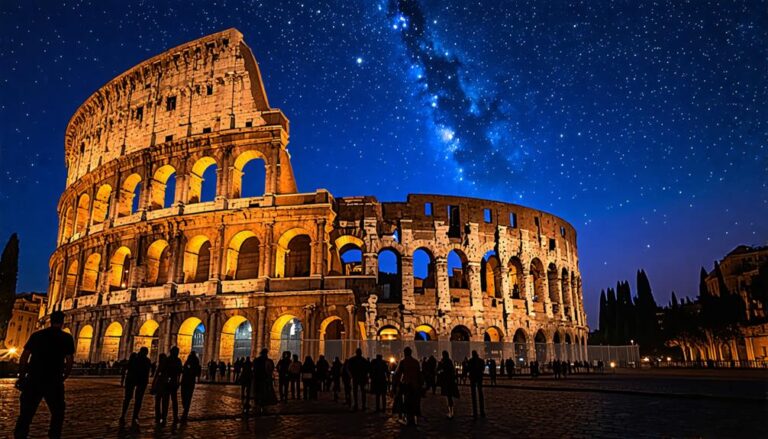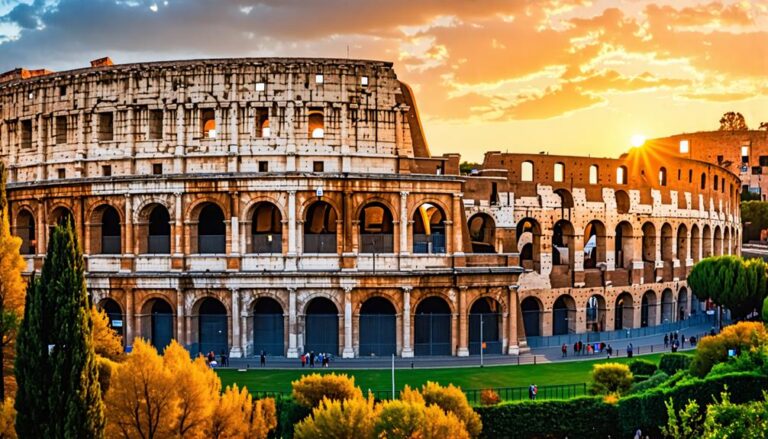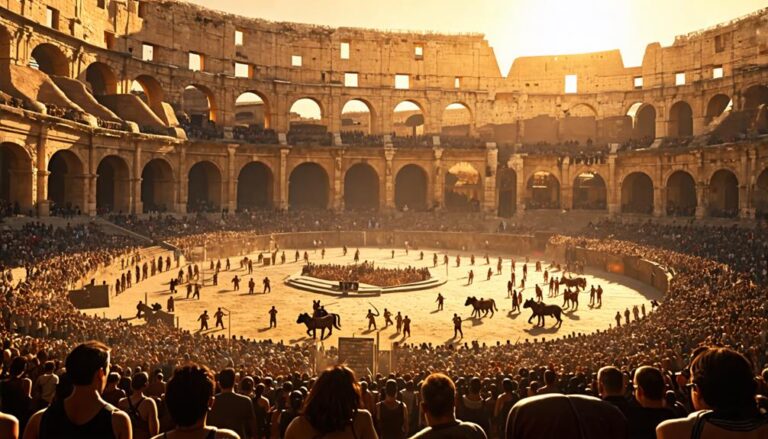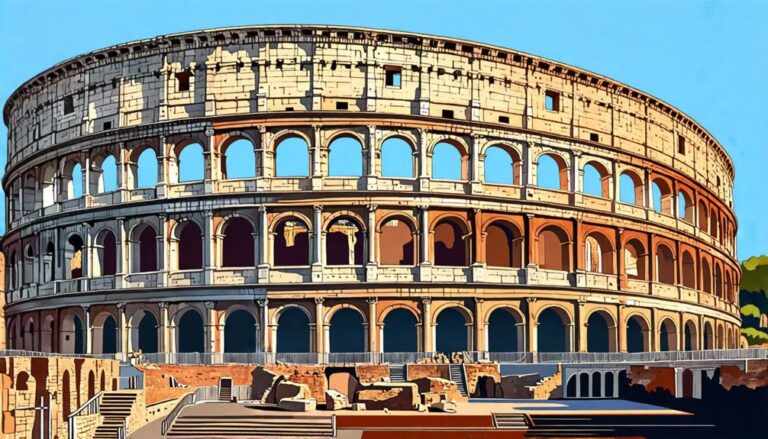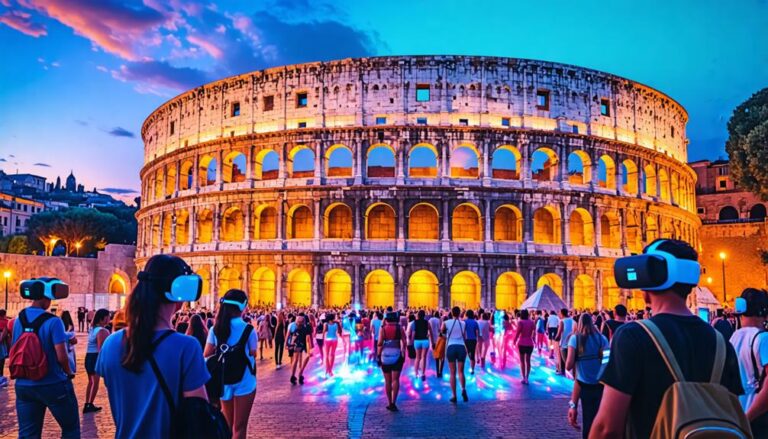Colosseum: Icon of Ancient Rome
The Colosseum, built between 70-80 AD under Emperor Vespasian and originally named the Flavian Amphitheater, stands as a timeless icon of ancient Rome. It could hold up to 80,000 spectators, showcasing Rome’s architectural genius and vibrant social life. This elliptical marvel used advanced engineering, including vaults, arches, and a retractable velarium. For centuries, it hosted gladiatorial games and various spectacles, embodying the Roman spirit of ‘panem et circenses‘. Preservation efforts since the 19th century have kept its splendor intact, reflecting its historical and cultural significance. Exploring the Colosseum offers a glimpse into its rich legacy.
When planning a vacation to Rome, the Colosseum is a must-see. Its grandeur and history make it an unforgettable experience. As you walk through its ancient corridors, you can almost hear the echoes of the past. Imagine the excitement of the crowds, the bravery of the gladiators, and the grandeur of the Roman Empire. This iconic structure is not just a monument; it’s a portal to history.
Nearby, you can also visit other significant landmarks. The Roman Forum, Palatine Hill, and the Arch of Constantine are all within walking distance. Each site adds layers to your understanding of ancient Rome. The area is rich with historical narratives, making your sightseeing tour a journey through time.
For a complete experience, consider joining a guided tour. Expert guides provide in-depth knowledge and intriguing stories, enhancing your visit. They can share fascinating details about the Colosseum’s construction, its role in Roman society, and the lives of those who thrived and perished there.
Rome’s culinary scene also adds to the experience. After exploring the Colosseum, enjoy a meal at a nearby trattoria. Savor authentic Roman dishes like carbonara and cacio e pepe, paired with local wines. It’s the perfect way to end a day of sightseeing.
In summary, a visit to the Colosseum is a highlight of any Roman vacation. Its architectural brilliance, historical depth, and cultural significance make it a must-see. As you explore this ancient wonder, you connect with a past that still resonates today.
Key Takeaways
- Built between 70-80 AD, the Colosseum stands as a symbol of Rome’s shift from tyranny to public entertainment.
- For nearly five centuries, it hosted gladiatorial contests and grand spectacles, accommodating up to 80,000 spectators.
- The elliptical structure showcases advanced Roman engineering, including magnificent arches, sturdy vaults, and a retractable awning.
- Preservation efforts began in the 19th century. Modern projects ensure its structural stability and historical accuracy.
When you visit Rome, the Colosseum is a must-see. Its colossal size and intricate design will leave you in awe. Imagine the roaring crowds and fierce gladiatorial battles as you walk through its ancient corridors.
Don’t miss the chance to explore the underground chambers. They reveal secrets of how fighters and animals were prepared for the arena. The upper levels offer breathtaking views of Rome.
Remember to book tickets in advance. The Colosseum is one of Rome’s most popular attractions. Guided tours are available in various languages, enhancing your experience with detailed historical insights.
A trip to the Colosseum is not just sightseeing; it’s a journey back in time.
Historical Significance
The Colosseum is a must-see on any vacation to Rome. This iconic structure, built between 70-80 AD under Emperor Vespasian, was originally known as the Flavian Amphitheater. It symbolizes Rome’s transition from tyranny to a society focused on public entertainment. Its grandeur and the organizational prowess of the Roman Empire are evident in its capacity to accommodate 50,000 to 80,000 spectators.
For nearly five centuries, the Colosseum hosted gladiatorial contests and public spectacles. These events entertained the masses and fostered social cohesion. The amphitheater’s inauguration, marked by 100 days of games, showcased the empire’s wealth and its ability to provide structured, mass entertainment.
After the fall of the Western Roman Empire, the Colosseum didn’t fade into obscurity. It found new purposes over the centuries, serving as a fortress and later as a Christian shrine. This adaptability highlights its enduring historical significance. Today, it’s a UNESCO World Heritage Site. The Colosseum remains an enduring symbol of ancient Rome‘s architectural and cultural legacy. It influences future designs and stands as a key historical landmark.
When planning your Rome sightseeing, make sure to visit this magnificent relic. The Colosseum offers a glimpse into the past, letting you experience the grandeur of ancient Rome firsthand.
Architectural Features
Let’s dive into the wonders of the Colosseum’s architecture, showcasing the brilliance and engineering skill of ancient Rome.
This iconic structure, elliptical in shape, is the largest amphitheater ever built, stretching approximately 190 meters long and 160 meters wide. Constructed primarily with travertine stone blocks, it required about 100,000 cubic meters of material, all held together by 300 tons of iron clamps.
The Colosseum features four distinct levels. Each level has a complex system of vaults and arches. The outer facade includes three classical orders: Doric, Ionic, and Corinthian. These elements not only gave structural strength but also added a majestic beauty that has amazed viewers for centuries.
With 80 entrances, the Colosseum made crowd management efficient and provided excellent visibility for spectators. It also had a retractable velarium, or awning, designed to shade the audience. Supported by masts fixed into corbels in the attic story, this feature demonstrated Roman innovation in ensuring spectator comfort.
These architectural marvels make the Colosseum a testament to the freedom and creativity of Roman engineering. If you’re planning a trip to Rome, visiting this historic site will be a highlight of your vacation. You’ll witness firsthand the ingenuity that has stood the test of time.
Construction and Labor
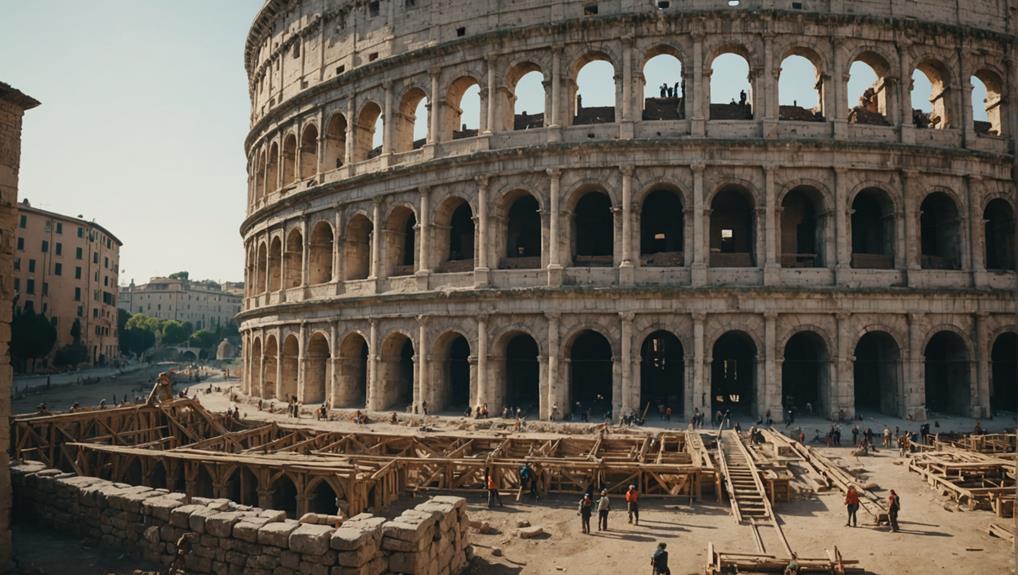
When planning a vacation to Rome, visiting the Colosseum is a must. This iconic amphitheater, built in the heart of ancient Rome, stands as a testament to architectural genius and historical significance. Constructed within a decade, the efficiency of project management was remarkable.
Jewish slave labor, captured after the Jewish Revolt, worked alongside skilled tradesmen to complete this monumental structure. The Colosseum’s grandeur is highlighted by the use of around 100,000 cubic meters of travertine stone and 300 tons of iron clamps. The engineering techniques employed were as astounding as the resources utilized.
Walking through the Colosseum, you can almost hear the echoes of ancient crowds and gladiators. Its massive size and detailed design make it a prime example of Roman ingenuity. When you’re in Rome, standing in the shadow of the Colosseum is an experience you won’t forget.
Jewish Slave Labor
When you visit Rome, the Colosseum is a must-see. Built around 70 AD, this iconic structure stands as a testament to ancient engineering and history. The Roman authorities used Jewish slave labor for its construction after the Jewish Revolt. Captured Jews were forced to toil under grueling conditions. Their hard work played a key role in building this architectural wonder.
The Colosseum wasn’t just about muscle power. Skilled tradesmen also worked on the project. They handled engineering, stone carving, and masonry. Their expertise ensured the Colosseum’s structural integrity and stunning design.
Let’s break down the labor force behind the Colosseum:
| Labor Force | Role | Impact |
|---|---|---|
| Jewish Slaves | Manual labor, heavy lifting | Crucial for construction, endured extreme hardships |
| Skilled Tradesmen | Engineering, stone carving, masonry | Ensured structural integrity and intricate design |
| Roman Contractors | Project oversight, management | Coordinated efforts, ensured efficiency |
Think about the human cost next time you marvel at the Colosseum’s grandeur. It’s a mix of sweat, skill, and strategy. The Roman Empire used a diverse labor force, highlighting their complex societal dynamics.
Project Management Efficiency
The Colosseum in Rome is a must-see attraction for anyone visiting the city. This ancient marvel, completed in just a decade, showcases Roman engineering and labor coordination.
Built between 70 AD and 80 AD, the Colosseum’s rapid construction was managed by dividing the project among four contractors. Each contractor handled a separate quadrant, ensuring work progressed simultaneously across the vast structure.
The use of Jewish slave labor, acquired after the Jewish Revolt, significantly increased the workforce’s size. This fact raises ethical concerns about ancient labor practices. Yet, it demonstrates the Romans’ ability to mobilize and manage large groups of workers efficiently.
The engineering techniques used in the Colosseum also played a crucial role in its swift construction. Romans used travertine stone blocks, concrete, and an intricate system of vaults and arches. These advanced methods not only sped up the building process but also ensured the Colosseum’s long-lasting durability.
One striking feature is its capacity to hold up to 80,000 spectators, with 80 entrances for easy access. This aspect highlights the Romans’ expertise in crowd management and logistics, essential for hosting large-scale events.
The Colosseum remains a symbol of Roman ingenuity and organizational skill. When you visit, you not only see a structure but a testament to ancient Rome’s remarkable achievements in engineering and coordination.
Resource Utilization Techniques
When planning a vacation to Rome, the Colosseum is a must-see landmark. This ancient marvel stands as a testament to Roman ingenuity and strategic planning. The rapid construction of the Colosseum is fascinating. The Romans used their resources and labor force expertly. They divided the project among four contractors, each handling a different section. This approach ensured a quick and efficient build. Amazingly, they completed the Colosseum in just a decade, unlike the centuries it took to build medieval cathedrals.
Resource utilization played a crucial role. The Romans employed Jewish slaves, captured after the Jewish Revolt of 72 AD. Their forced labor significantly sped up construction. The Romans also used travertine stone, about 100,000 cubic meters, bound meticulously with around 300 tons of iron clamps. Skilled tradesmen worked alongside the slaves, blending expertise with sheer manpower.
The architectural design of the Colosseum is sophisticated. It features a complex system of vaults and arches, showcasing advanced engineering techniques. This mix of skilled and forced labor created an efficient workforce, maximizing output. By leveraging both human and material resources effectively, the Romans erected an enduring symbol of their empire. Their methods in resource utilization and labor coordination remain a powerful example of ancient engineering prowess.
Visiting the Colosseum today offers a glimpse into this incredible history. You can marvel at the architectural brilliance and imagine the bustling activity that once took place here. It’s more than a sightseeing spot; it’s a journey back to an era of remarkable achievements. So, when in Rome, make sure to explore this iconic structure and appreciate the historical significance it holds.
Engineering Innovations
The Colosseum is a must-see when vacationing in Rome. Roman engineers showcased their unparalleled ingenuity through the Colosseum’s intricate system of vaults and arches. This allowed it to support thousands of spectators and endure through centuries. The Flavian Amphitheater stands as a representation of ancient Rome’s engineering marvels. They used about 100,000 cubic meters of travertine stone. The outer wall was bound together with 300 tons of iron clamps. These techniques highlight the sophisticated construction methods of the time.
The Colosseum’s design included a retractable awning, or velarium, which provided shade to spectators. Supported by masts anchored in the attic story, this feature showed the Romans’ commitment to comfort and innovation. The amphitheater had 80 entrances, making crowd management efficient. This allowed up to 80,000 spectators to quickly enter and exit during events.
The arena floor had trapdoors for special effects during spectacles, showcasing the Romans’ flair for stage design. These engineering marvels ensured the Colosseum’s functionality and durability. The Flavian Amphitheater wasn’t just a venue for events; it was a groundbreaking achievement in architectural design and public convenience.
Gladiatorial Contests
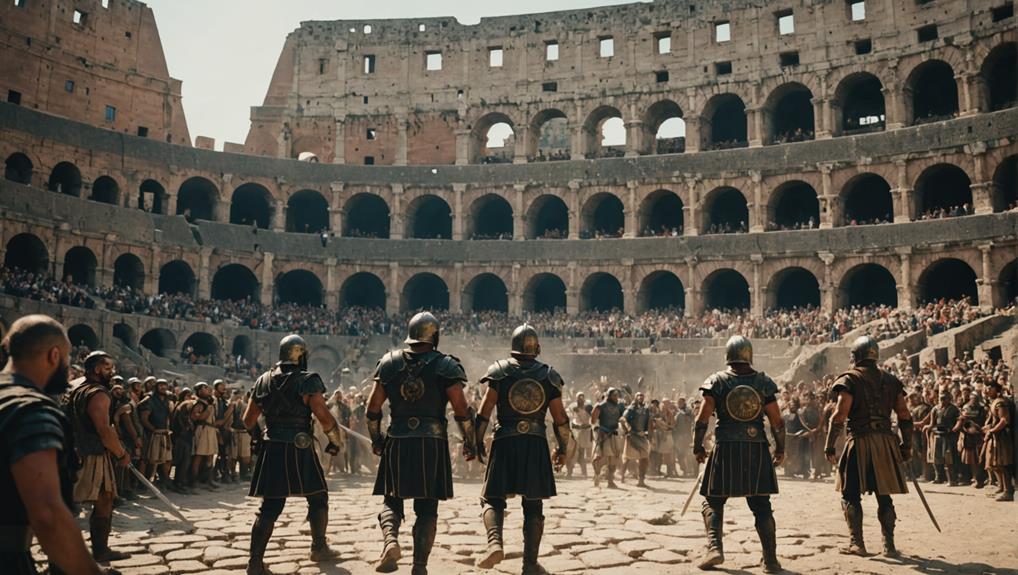
The Colosseum, beyond its architectural brilliance, was the heart of gladiatorial contests that fascinated thousands for centuries. These events at the Flavian Amphitheatre weren’t just brutal fights; they were meticulously planned spectacles that drew crowds ranging from 50,000 to 80,000 people.
Gladiatorial contests featured trained fighters, often slaves or prisoners, who battled for survival, fame, and sometimes freedom. A typical day’s schedule was a gripping sequence of events:
- Morning: Wild animal hunts (venationes)
- Midday: Executions of condemned criminals
These contests were more than mere entertainment. They embodied the Roman philosophy of ‘panem et circenses,’ or ‘bread and circuses,’ designed to appease and distract the populace during times of political unrest. Gladiators fought under various rules, either in single combat or against multiple opponents. Their victories could lead to newfound celebrity status and even emancipation.
The last recorded gladiatorial games in the Colosseum occurred in 404 AD, signaling the decline of this bloodsport as the Roman Empire shifted towards Christianity. Despite the passage of time, the legacy of these contests remains a defining aspect of the Colosseum’s storied history.
When you plan your vacation to Rome, make sure to visit the Colosseum. It’s a unique experience to stand where these epic battles took place. The structure itself is a marvel, and the history it holds is palpable. You can almost hear the roars of the ancient crowds and feel the tension of the gladiators awaiting their fate.
A visit here isn’t just a sightseeing trip; it’s a journey back in time to understand the grandeur and complexity of ancient Roman culture.
Public Spectacles
The Colosseum’s public spectacles captivated audiences with their grandeur and variety. From thrilling wild animal hunts to dramatic gladiatorial battles, these events drew crowds of 50,000 to 80,000 spectators. Visitors were eager to witness the splendor of Roman entertainment. The Colosseum’s inauguration featured 100 days of games, showcasing morning wild animal hunts, midday comedies with condemned criminals, and afternoon gladiator battles as the main attraction.
These meticulously organized public spectacles aimed to impress and distract the populace. The phrase ‘panem et circenses’—bread and circuses—encapsulated this practice. It aimed to maintain social order by providing food and entertainment, keeping the masses content and engaged. The 80 entrances of the Colosseum facilitated efficient crowd flow, allowing spectators quick access and exit during the events.
Elaborate special effects, like trapdoors for surprise appearances of gladiators and wild animals, heightened the dramatic experience. These spectacles weren’t just about violence and combat; they demonstrated the ingenuity and organizational prowess of Roman society. The Colosseum stands as a symbol of the Empire’s ability to captivate and control its people through grand displays of power and entertainment.
When planning your vacation to Rome, the Colosseum should be at the top of your list. Its rich history and architectural marvel will leave you in awe. Standing in the arena, you can almost hear the roars of the ancient crowd and the clash of swords. It’s a must-see sight that offers a glimpse into the grandeur of ancient Rome. So, make sure to include the Colosseum in your sightseeing itinerary. You won’t regret it.
Cultural Impact

The Colosseum is a must-see for anyone vacationing in Rome. This ancient amphitheater, built between AD 72 and 80, is one of the most iconic landmarks in the world. It stands as a testament to the grandeur and architectural ingenuity of the Roman Empire.
Exploring the Colosseum isn’t just about marveling at its massive structure. It’s about stepping into history. Imagine the roar of 50,000 spectators, the clash of gladiators, and the thrill of wild animal hunts. This vivid imagery brings the past to life.
The phrase ‘bread and circuses’ captures the essence of the Colosseum in ancient Roman society. Public spectacles here were designed to entertain and placate the masses. This concept holds true even today. Leaders often use entertainment to influence public sentiment.
Beyond its historical significance, the Colosseum has a lasting cultural impact:
- Art and Literature: Many artists and writers have taken inspiration from the Colosseum. It has appeared in countless works, from Renaissance paintings to modern novels.
- Film and Media: The Colosseum frequently appears in movies and documentaries. Its iconic status makes it a favorite subject.
Visiting the Colosseum is more than just sightseeing. It’s about connecting with a piece of history that continues to shape our world. Its grand design and historical importance leave a lasting impression on all who see it.
Decline and Preservation
The Colosseum’s decline began when gladiatorial games were halted in 404 AD. Without its primary purpose, this grand amphitheater fell into disrepair. The fall of the Western Roman Empire accelerated its decline. The once-mighty structure was repurposed for various uses, including as a church and a fortress. These new roles led to further deterioration, exposing the Colosseum to the ravages of time and neglect.
Efforts to preserve this iconic monument began in earnest in the 19th century. Pope Pius VIII spearheaded initial restoration projects, focusing on maintaining the Colosseum’s historical integrity. These early actions laid the groundwork for future preservation initiatives aimed at combating damage from natural disasters and vandalism.
In 1980, the Colosseum was designated a UNESCO World Heritage Site. This underscored its global significance and the urgent need for preservation. Today, ongoing restoration projects, funded by ticket sales and private donations, work to protect the Colosseum from environmental damage and ensure its structural stability. By investing in these preservation efforts, we honor the Colosseum’s legacy and ensure its grandeur endures for future generations.
When you visit Rome, the Colosseum stands as a must-see marvel. Imagine walking through history as you explore this ancient amphitheater. Its towering arches and intricate architecture tell stories of gladiators and emperors.
Whether you’re snapping photos or taking a guided tour, the Colosseum offers a unique glimpse into the past. Don’t forget to book your tickets in advance, as this iconic site draws crowds from around the world. Enjoy every moment of your visit and make memories that will last a lifetime.
Modern Restoration
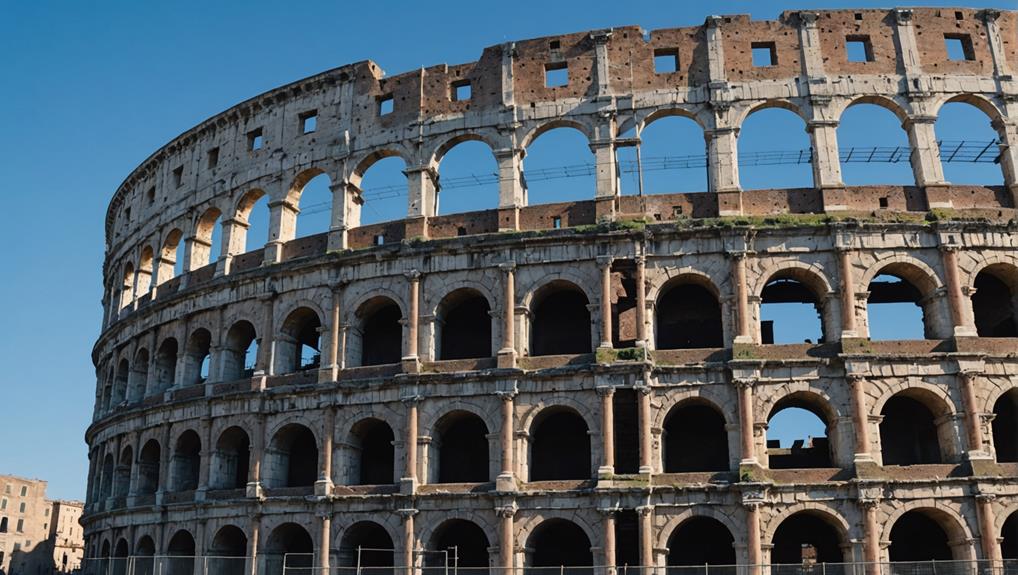
Exploring the Colosseum during your vacation in Rome offers a unique blend of history and awe. This ancient amphitheater stands as a testament to Roman engineering and culture. Visiting this monumental structure, one can’t help but marvel at its grandeur.
Imagine walking through the arches where gladiators once entered. The Colosseum’s massive stone walls tell stories of epic battles and grand spectacles. This site draws millions of visitors each year, eager to step back in time.
As you stroll around the Colosseum, the sheer scale of the arena becomes evident. Its complex design, with tiered seating and intricate passageways, showcases Roman ingenuity. Despite centuries of wear, the Colosseum remains a symbol of Rome’s enduring legacy.
Your vacation in Rome is incomplete without seeing the Colosseum. This iconic landmark not only exemplifies ancient architecture but also embodies the spirit of Rome. Whether you’re a history buff or a casual traveler, the Colosseum promises an unforgettable experience.
Efforts to maintain the Colosseum’s structural integrity are ongoing. Pollution and natural disasters present significant challenges. Reinforcing the structure is essential to preserve its historical authenticity. Public and private funding supports these projects. By raising public awareness, we aim to protect this iconic monument for future generations.
Rome’s warm climate makes sightseeing pleasant. Consider visiting during spring or fall to avoid the summer crowds. Local guides offer valuable insights, enhancing your experience. Each corner of the Colosseum reveals new details, making every visit unique.
Structural Integrity Maintenance
When planning a vacation to Rome, the Colosseum is a must-see attraction. Modern restoration projects address damage from pollution, earthquakes, and centuries of neglect to guarantee its structural integrity. These efforts preserve the historical authenticity of this ancient marvel. By revealing the original colors of stucco and travertine, we ensure proper conservation techniques reflect its grandeur closely to its original state.
Significant funding comes from ticket sales and private donations. In 2018 alone, visitor admissions generated an impressive $63.3 million. These funds support ongoing structural reinforcements and maintenance work, combating deterioration and ensuring the site remains safe and stable for the millions of visitors it attracts annually.
Key aspects of our structural integrity maintenance include:
- Conducting regular structural reinforcements to address wear and tear.
- Implementing studies of local underground construction impacts to inform preservation strategies.
Environmental Damage Prevention
Visiting Rome is a dream for many, and the Colosseum stands as a must-see landmark. This ancient amphitheater, built nearly 2,000 years ago, offers a window into the grandeur of Roman civilization. Yet, while it captivates millions, its preservation faces significant challenges.
Pollution and weather constantly wear down the Colosseum’s travertine stone. To fight these threats, we’ve adopted advanced conservation techniques. Protective barriers now shield the monument, and we treat stone surfaces to counter the effects of acid rain and airborne pollutants.
But our work doesn’t end there. Continuous monitoring is crucial, as studies show the Colosseum’s travertine is especially vulnerable to environmental factors. By staying vigilant, we can address issues as they arise. Funding for these restoration projects comes from ticket sales, private donations, and government support. This blend of sources highlights a collective effort to preserve this historical marvel.
We also partner with archaeologists and historians. Together, we develop educational programs to raise awareness about the Colosseum’s vulnerabilities and the importance of environmental protection in heritage conservation. These programs not only protect the structure but also engage the public in our mission, fostering a shared responsibility for its preservation.
Through these combined efforts, we aim to protect the Colosseum. Our goal is to ensure its endurance for future generations to admire and learn from.
Historical Authenticity Efforts
Let’s explore the modern restoration efforts that meticulously preserve the Colosseum’s historical authenticity and structural integrity. Since the 19th century, these efforts have been essential in maintaining the iconic monument’s grandeur. Under Pius VIII, initial projects laid the foundation for future preservation. Today, the Colosseum benefits from advanced technology and dedicated funding, ensuring its longevity for generations.
Recent restoration projects focus on addressing the various forms of decay that threaten the Colosseum:
- Pollution and weathering: These elements have damaged the structure over the centuries.
- Past vandalism: Historical and modern acts of vandalism have left scars that need careful restoration.
Funding from ticket sales and private donations has been essential in these endeavors. As a UNESCO World Heritage Site since 1980, the Colosseum’s preservation isn’t just about maintaining a structure; it’s about safeguarding a cultural and historical treasure. Educational campaigns and exhibitions have also played an essential role, raising public awareness about the importance of preserving this ancient marvel.
When you plan a vacation to Rome, the Colosseum should top your sightseeing list. Imagine walking through the ancient amphitheater like gladiators once did. Each stone tells a story of the past. You can feel the weight of history in the air. The Colosseum stands as a testament to Roman engineering and culture.
Don’t miss the guided tours. They offer deep insights into the Colosseum’s history. Advanced booking is a good idea, as it can get crowded. Nearby, you’ll find other attractions like the Roman Forum and Palatine Hill. These sites add layers to your understanding of ancient Rome.
Visiting the Colosseum is more than just another tourist activity. It’s a journey through time. You get to witness restoration efforts up close. You also support the ongoing preservation of this world wonder. So, pack your bags and get ready for an unforgettable Roman adventure.
Visitor Information
To make the most of your visit to the Colosseum, arrive 30 minutes early for security checks. This iconic landmark of ancient Rome welcomes visitors daily from September 1-30, operating between 9:30 am and 7:00 pm. However, it’s closed on December 25 and January 1, so plan accordingly.
Only small bags are permitted inside, so pack light to breeze through security. Wheelchair users should note that accessibility is limited to the ground floor, so plan your visit with this in mind.
To avoid crowds, consider visiting during the off-season from November to April. Advance booking is essential during the high season from May to October. Tickets can be purchased online or at Coop Culture. Using the Roma Pass can save time by bypassing long queues.
Travel light, arrive early, and plan your visit with these tips. This will ensure a memorable trip to this iconic symbol of ancient Rome. Embrace the freedom of exploring history without unnecessary hassles.
Ticketing and Access
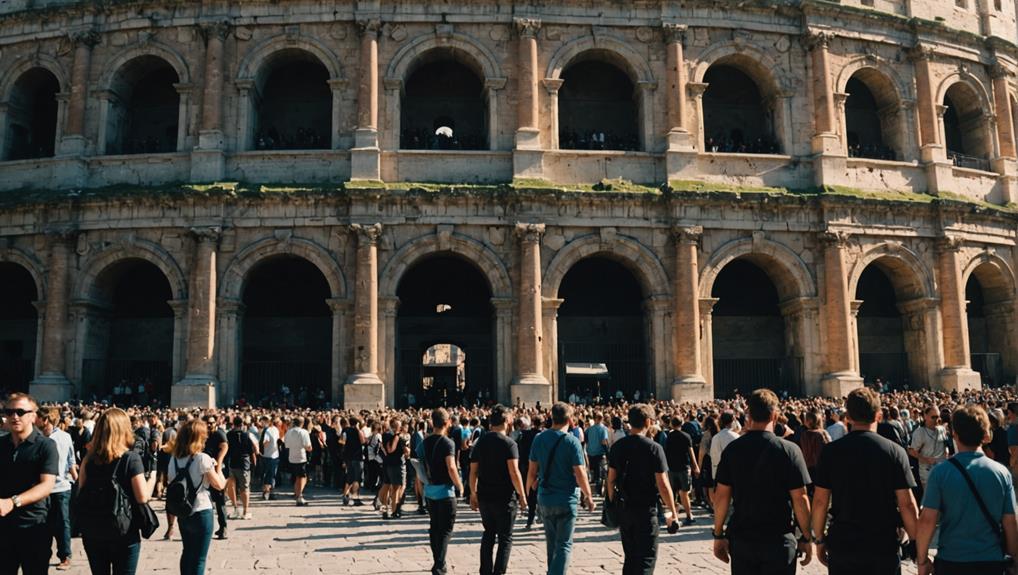
When planning your visit to the Colosseum, consider purchasing tickets online through Coop Culture for convenience and to avoid long queues.
Arrive early to accommodate security checks, keeping in mind the restrictions on bag sizes.
Accessibility remains limited, with wheelchair users confined to the ground floor.
Pre-reserved tickets can enhance your experience by providing smoother entry.
Purchasing Tickets Online
Purchasing tickets online for the Colosseum through official platforms like Coop Culture allows you to skip long queues and ensures a smoother entry. By securing your tickets in advance, you avoid the hassle of waiting and guarantee you don’t miss out on this iconic landmark, especially during the busy season from May to October.
Selecting the right ticket type is essential, as most entry tickets include access to the Roman Forum and Palatine Hill, providing a comprehensive experience of ancient Rome.
Booking online offers several benefits:
- Discounts: EU citizens aged 18-25 get reduced prices, while children under 18 can enter for free, though they still need a ticket.
- Time Slot Selection: You can choose your preferred entry time, helping you plan your visit efficiently.
Arriving at least 30 minutes before your scheduled entry time is recommended to account for security checks, as only small bags are allowed inside.
Following these guidelines maximizes your visit to the Colosseum, letting you fully immerse yourself in its historical grandeur. Enjoy your journey through time without unnecessary delays.
Accessibility and Entry Guidelines
Vacations to Rome Colosseum
Many visitors are delighted to find that tickets for the Colosseum are easily available online. This simplifies the entry process. Opting for the Roma Pass gives additional access to the Roman Forum and Palatine Hill, enhancing our visit.
Arriving at least 30 minutes early for security checks is crucial, as only small bags are allowed inside.
The Colosseum offers some accessibility features for wheelchair users. However, access is limited to the ground floor. Other areas may not be as wheelchair-friendly, which can limit our exploration. Despite this, the historical richness of the ground floor provides a substantial experience.
The Colosseum is open year-round, except for December 25 and January 1. From late September, opening hours are usually 9:30 am to 7:00 pm. This gives us ample time to explore.
Reading up on the history or joining a guided tour can offer detailed insights. This enriches our appreciation of this iconic monument. Following these entry guidelines ensures a seamless and informative visit.
Best Visiting Times
Best Visiting Times
Curious about the best time to visit the Colosseum? Picking the right moment can make your experience unforgettable. The high season, spanning May to October, attracts larger crowds. Booking in advance becomes crucial. If you crave a serene atmosphere with fewer people, consider the off-season from November to April. You might face a few storms, but the tranquil setting can be worth it.
To maximize our visit, we should:
- Book ahead to guarantee entry, especially during busy months.
- Arrive at least 30 minutes early for security checks and to absorb the historical ambiance.
The Colosseum operates from 9:30 am to 7:00 pm in September. It stays closed on December 25 and January 1. While regular rain won’t close it, severe weather might.
Planning our visit around these details ensures we can explore stress-free. By timing our visit wisely, we can appreciate the grandeur and history of the Colosseum without the hassle of large crowds.
Frequently Asked Questions
Why Is the Colosseum a Symbol of Rome?
The Colosseum’s architecture and history embody Rome’s essence. Its grand design and the tales of gladiators transport us to a time when strength and entertainment were intertwined. It stands as a testament to Roman ingenuity.
Visiting the Colosseum offers a unique glimpse into ancient Roman life. Imagine the roar of the crowd and the thrill of the games. This iconic structure remains a symbol of Rome’s rich heritage and cultural legacy.
A trip to Rome isn’t complete without exploring the Colosseum. Its imposing arches and detailed engineering make it a must-see on any Roman vacation.
What Is the Symbol of the Colosseum?
The Colosseum in Rome isn’t just about grand architecture or rich history. It’s also a clever distraction from Rome’s real issues. We marvel at its engineering, forgetting it masked societal problems with ‘bread and circuses.’
When planning a vacation to Rome, visiting the Colosseum is a must. This iconic symbol of ancient Rome stands as a testament to Roman engineering prowess. Constructed in AD 80, it could seat up to 50,000 spectators. People came to watch gladiatorial contests and public spectacles. The sheer scale of the Colosseum is awe-inspiring.
But there’s more beneath the surface. The Roman emperors used the Colosseum to entertain the masses and distract them from economic and political troubles. This strategy, known as ‘bread and circuses,’ kept the citizens content with free food and entertainment.
As you explore the Colosseum, remember its dual role in Roman society. It was both a marvel of architecture and a tool for social control. Your visit will be more enriching if you appreciate this complex history. So, pack your bags and prepare to step back in time. Rome awaits you.
Is the Colosseum an Icon?
The Colosseum’s architecture and history make it an undeniable icon. It stands as a symbol of Roman innovation and grandeur. Millions visit, eager to connect with the past and the freedom it represents.
During vacations to Rome, the Colosseum is a must-see. This ancient amphitheater, built in AD 80, showcases Rome’s engineering prowess. Imagine gladiators battling and crowds roaring. It’s a vivid glimpse into ancient Roman life.
The structure is an engineering marvel. Its arches and columns inspire awe. The Colosseum could hold up to 80,000 spectators. Its design influenced modern stadiums.
When planning your Rome sightseeing, put the Colosseum at the top of your list. It’s more than a ruin; it’s a testament to human ingenuity. Walking through its corridors, you can almost hear the echoes of history.
What Was the Colosseum in the Ancient Rome Famous For?
When planning a vacation to Rome, the Colosseum is an essential sight to see. Picture the ancient amphitheater echoing with the cheers of thousands of spectators. It was famous for its gladiatorial games, which showcased the essence of freedom and intense competition.
The Colosseum’s architectural grandeur and innovative designs enchanted visitors. Its massive stone and concrete structure stood as a symbol of Roman engineering prowess.
Exploring the Colosseum today, you can almost feel the history embedded in its walls. It’s a must-see for anyone fascinated by ancient Rome’s culture and achievements.
Conclusion
The Colosseum is a must-see on any vacation to Rome. Its rich history and stunning architecture captivate everyone. Built with advanced engineering and immense labor, this ancient arena hosted thrilling gladiatorial contests. Today, it stands as a tribute to Rome’s grandeur and a living connection to our shared cultural heritage.
Exploring the Colosseum, you’ll marvel at its unique arches and massive stone blocks. Restoration efforts keep it preserved for future generations. This iconic monument symbolizes the glory of ancient Rome.
Cherish your visit to the Colosseum. It’s an unforgettable experience that links you to the past. Make sure to protect and appreciate this ancient wonder during your trip.
